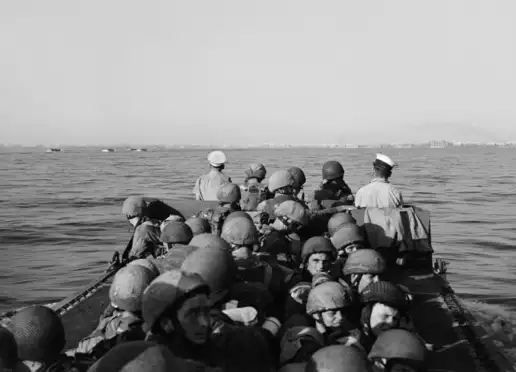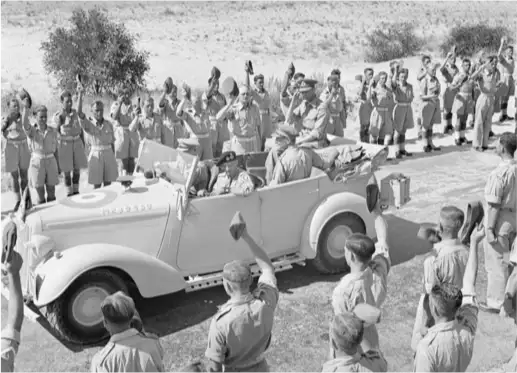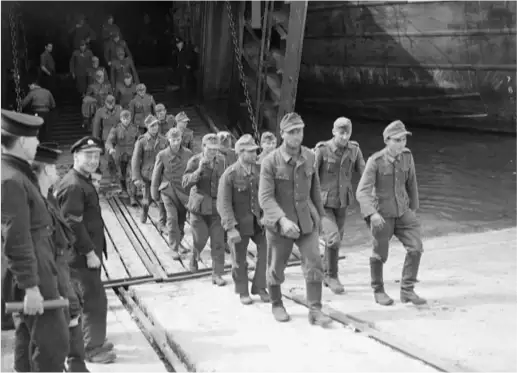
 Experience the dynamic campaign in game with
Experience the dynamic campaign in game with 
 Find out more
Find out moreThe Salerno invasion saw the Allies approach mainland Italy in a fierce amphibious assault during World War II. In between the chaos and the combat, however, a number of remarkable stories stand out.
Steadfast soldiers and courageous civilians combined in a Salerno POW escape saga worthy of Hollywood, while the Salerno mutiny saw misunderstanding and comradeship take a tragic turn.
From heroic acts of collective and individual bravery to wartime secrets more recently unearthed, we dive into the experiences of the real people who were there.

At Eighth Army Tactical Headquarters.
The British 8th Army would split up and carry out Operation Baytown and Slapstick, while the US 5th Army prepared for the Salerno invasion.
While the US 5th Army approached battle in the Gulf of Salerno, the British 8th Army would begin their long advance north from Calabria to reunite the two armies.
Did you know?
From the start of the Salerno landings on September 9th, to October 1st, 1943, the number of Allied resources that crossed the beachhead came to:
Learn more about the Salerno Landings in Facts, Figures and Statistics

British airborne troops approaching Taranto in a landing craft, during the invasion of Italy, 14 September 1943.
“Montgomery was supposed to bring thousands of British troops up from the south and meet them there [at Salerno]. In the American mind, Montgomery was going way too slow.”
- World War Two historian Bill Beigel
The mutiny at the Battle of Salerno is perhaps one of the lesser-known tales of the Italian campaign. In fact, a 75-year ban on official court martial papers buried the event for 50 years, until it was prematurely lifted in 1993.
So, what drove 191 men to disobey their orders on the coast of Salerno in September 1943?
The men were told they would be reunited with their units, who they knew were somewhere in Italy. Indeed, General Montgomery strongly believed that keeping men with their units as much as possible was key to maintaining morale. After all, these are the bonds that weld soldiers together and help keep their heads held high.
With that promise in their ears, the British 8th Army eagerly signed up.

HM King George VI rides with General Montgomery in Tripoli, 21 June 1943.
However, rather than reuniting with their units as they were told, the men were instead sent to fight alongside Clark’s US 5th Army to support the Salerno invasion. When they arrived in Salerno, the emergency had already blown over and their services were no longer required. They were left in a field by the coast, waiting to be told what to do next.
Eventually, orders called for them to advance north, but almost 200 refused – mostly troops from the 50th Tyne Tees and 51st Highland Divisions.
It is important to note that these men were not shying away from the fight – they simply wished to fight with their own units. Their refusal to follow the order was in many ways a spontaneous response to what they thought had been a serious and genuine mistake.
“When they got to these other outfits, their unit cohesion was ruined,” Beigel explains, noting how much pride the men had in their units, some of whom had even fought together in World War I. “There was a definite affinity that these guys felt for their own military units.”
But mutiny was a capital offence, and those who refused their orders were held in a prisoner of war cage next to German prisoners, before being sent back to North Africa. Of the men who stood their ground, three sergeants, 16 corporals and approximately 170 additional men faced a court martial.

Salerno, 9 September 1943 (Operation Avalanche): British troops and vehicles from 128 Brigade, 46th Division are unloaded from LST 383 onto the beaches.
Did you know?
In July 1943, Italy’s fascist dictator Benito Mussolini was removed and Marshal Pietro Badoglio was appointed in his place.
By August, General Dwight D. Eisenhower and the new Badoglio government were engaging in secret negotiations arranging Italy’s surrender to the Allies. They announced their new armistice agreement one day before the Salerno invasion.
These secret negotiations helped inform the Allied attack of the port of Taranto in Operation Slapstick. Meanwhile, valuable intelligence on Axis defences, mines and potential landing points came from sources such as:

Major General Dwight Eisenhower
By the time the Italian armistice was declared on 8th September 1943, approximately 80,000 Allied prisoners of war (POWs) were being held captive in Italy.
The incredible true story of two such POWs who mounted their own ‘great escape’ took place around this very time, with the bravery and generosity of local Italian families coming to their aid.
Lieutenant-Colonel Frank Simms served in the Long Range Desert Group, a British reconnaissance and raiding unit. He was caught while behind enemy lines in Libya, in January 1942.
Simms was shipped to a POW camp in the Salerno region – the breath-taking Certosa di Padula monastery, now a UNESCO World Heritage Site.
He ran until exhaustion took hold, and by chance, stumbled upon a young Italian boy who found him new clothes, food and a map. A week later, he was joined by another POW who had escaped from a train. Peter Medd was a naval officer, and together they began a two-month trek across Italy.
Over the course of their remarkable journey, Simms and Medd survived due to the generosity of courageous Italian families who gave them food and shelter, risking everything to help the Allied POWs. One family in particular, named the Abramis, let the men stay in a chestnut-drying hut in Roggio, Lucca, while Medd tended to blistered feet and boils.
Eventually, the two found sanctuary when they came across a Canadian officer in Lucito, 100 miles north of Naples. Their remarkable journey is detailed in the memoir co-written by the two soldiers, The Long Walk Home: An Escape in Wartime Italy.

German soldiers who were captured in Normandy disembarking from a LST at Southampton
Did you know?
There were also many Axis POWs from the battle of Salerno, who were sent to Great Britain and the United States.
“The [Germans] that were captured there were the fortunate ones,” says Beigel.
Over the course of the war, Axis prisoners were sent to work on farms in states like Kansas, Montana, Oklahoma and Iowa. Meanwhile, POWs were a solution to Britain’s labour shortage at the time. “These guys got out of a very difficult situation there,” Beigel notes, referring to the war in Italy.
When they weren't working, Axis POWs were often free to explore their local towns.
Their relatively light treatment in the United States put into perspective the injustices of the American Jim Crow laws at the time. Segregation in the US didn’t end until 1964, which meant African American servicemen had fewer liberties in their own country than the white Axis prisoners of war, who could use services and facilities they could not.
©Relic Entertainment. All rights reserved. Developed by Relic Entertainment. Entertainment, the Relic Entertainment logo, Company of Heroes and the Company of Heroes logo are either registered trademarks or trademarks of Relic Entertainment. Relic Entertainment is registered in the U.S. Patent and Trademark Office. All other trademarks, logos and copyrights are property of their respective owners.